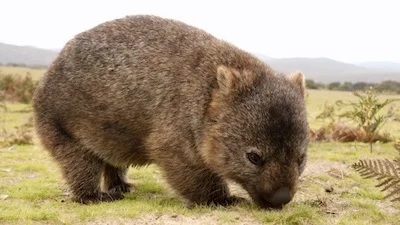Wombats are marsupials.
Babies live in their mother's pouch for six months.
Wombats dig dens with tunnels.
They eat plants at night.
They stay in a den in daytime.
Wombats are part of the marsupials group of mammals and are closely related to koalas.
Common, or bare-nosed, wombat. ©Getty Images
The common (or bare-nosed) wombats that are in Tasmania and Flinders Island are a little bit different from those found on mainland Australia. There are two species, or kinds, of hairy-nosed wombat : the southern and the northern.
Habitat and Distribution (where they are found)
Common wombats were once found all over southeast Australia, but now are found mainly in the coastal regions of southeast Australia, stretching along the east coast through New South Wales and into Queensland. Those in Tasmania are widespread across the state. They live in woodlands and scrublands in hilly and mountain areas.
Southern hairy-nosed wombat. ©Getty Images
Southern hairy-nosed wombats are found in the southern part of central Australia, in the Nullabor Plain of South Australia and into Western Australia. They live in dry inland areas such as grasslands and open woodlands.
Northern hairy-nosed wombats used to be found from northern Victoria, through New South Wales and a quarter of Queensland. Now however, there is just one small population of them in the Epping forest in the eastern part of central Queensland. Their habitat is dry grasslands. The climate is harsh and hot, with low rainfall and frequent droughts.
Appearance and Behaviours
Wombats are solid animals with short muscular legs. Adults measure almost one metre long from nose to tail, the tail being only a couple of centimetres long. An adult weighs about 25-35 kilograms.
Northern hairy-nosed wombat ©Getty Images
Wombats are the largest burrowing mammals. They are covered with coarse grey or brown fur, with a large head, a large nose and small ears. They are solidly built, with large claws for digging. The body has a rounded appearance. Its back, towards the tail end, is hard and bony. This bony back is a useful defence against intruders in the burrow, as the wombat uses its back to crush them against the burrow wall.
Tasmanian common wombat in burrow entrance ©Getty Images
The nose of the common wombat is naked and its ears are rounded. Both the hairy-nosed wombat species have softer fur than the common wombat, and, as their names suggest, their noses are fur-covered. Their ears are pointy. The northern hairy-nosed wombat has a broader muzzle and its eyes are ringed in black.
The wombat is nocturnal, which means it is active at night, eating grasses, roots and shrubs. It stays in its cool burrow in the daytime, though sometimes can be seen basking in the sun at the burrow entrance. It lives alone, except for a female with young. Some wombat burrows can be about 20 metres long, with several entrances and chambers. A wombat generally has a number of burrows in its territory, and may visit several during its nightly wanderings.
The wombat marks its territory by leaving droppings (called scats) on logs and rocks. Wombat scats, or poo, is slightly cubed so that it doesn't roll off rocks and logs.
The female's pouch has its opening facing the back legs. This means that when she is digging, the pouch does not fill with soil.
Common wombat ©Getty Images
Life Cycle
Like all marsupials, wombat young are born in a very undeveloped state and finish their development outside the female's body, in a pouch. A female wombat gives birth to one very tiny young, called a joey, which moves to her pouch after being born. Twins are extremely rare. It stays in the pouch for about 6 months, suckling milk from a teat in the pouch. After it leaves the pouch, it will follow her for another 11 months.
Conservation Status and Threats
Common wombats are not endangered, although their habitat is decreasing.
The southern hairy-nosed wombat is listed as Vulnerable.
The northern hairy-nosed wombat is listed as Critically Endangered.
They have all suffered from loss of habitat and competition from introduced animals such as cattle, sheep and rabbits.
It’s a good idea to get information from more than one source!
Read more about all species of wombat here.
https://www.aws.org.au/wombat/
Read more about wombats and watch a video
https://www.bushheritage.org.au/species/wombats






